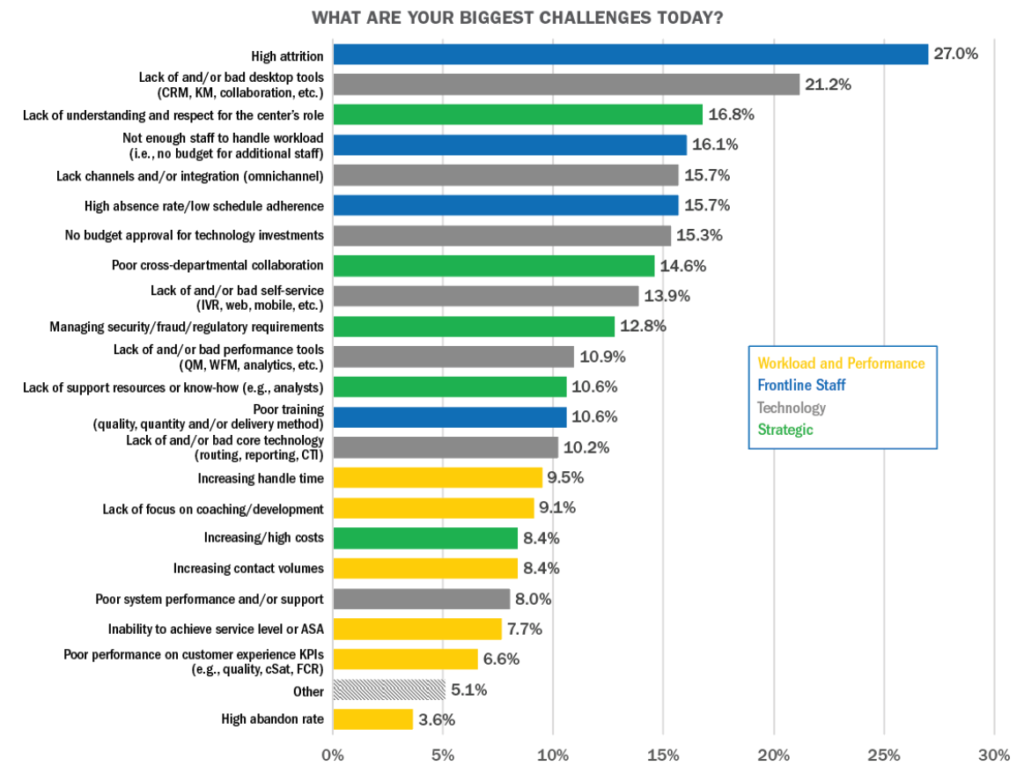High levels of employee turnover are, unfortunately, a common and costly challenge for contact centres. When agents leave, it takes significant time and resources to recruit and train them and even longer for them to become a truly effective member of a team. This leads to decreased efficiency, lower customer experience and ultimately reduced profitability. Below, we explore the causes and consequences of contact centre attrition and share ten practical tips for reducing turnover.

What is Contact Centre Attrition?
Contact centre attrition refers to the rate at which agents leave a company’s contact centre. While every area of business experiences a degree of employee turnover, the high turnover rates in contact centres, sometimes more than 100% over a year, can be particularly problematic.
Causes of Contact Centre Attrition
High attrition rates in contact centres are nothing new and typically are caused by several contributory factors. Looking beyond obvious areas such as low rates of pay, repetitive work and sometimes unsociable hours, a common cause can a lack of empowerment among agents. When agents don’t have the resources or flexibility to effectively respond to customer queries, they may feel frustrated or powerless, which can lead to demotivation and ultimately, departure.
Similarly an unhelpful working culture, where agents spend the majority of their day staring at screens can easily lead them to feel isolated from their colleagues and the wider company. One of a team leader’s primary aims should be to foster a strong sense of team spirit and offer opportunities for social interaction to help agents feel more engaged and motivated.
Recognition is another key factor that can affect attrition rates in contact centres. When agents feel that their achievements and hard work are not acknowledged, they may feel undervalued and unappreciated, which can make them more likely to seek out opportunities elsewhere.
Finally, subjective treatment and unfair reviews can also contribute to high attrition rates. When agents feel that they are being treated unfairly or that their managers are not providing constructive feedback, they may begin to feel disillusioned and unappreciated, which can ultimately lead to their departure.
Consequences of High Attrition Rates
As mentioned earlier, the consequences of high attrition rates can be considerable for contact centres. Recruiting, training and supporting new agents to competency is time-consuming and expensive, and turnover can lead to decreased quality of service and customer satisfaction. Additionally, high attrition rates can lead to low team morale, which can further exacerbate the problem by making it more difficult to retain existing agents.
10 Tips for Reducing Contact Centre Attrition

Reducing contact centre attrition is essential for improving efficiency, productivity, and profitability. Here are ten tips for reducing turnover rates in your contact centre:
Provide comprehensive training and support to agents to ensure that they have the skills and resources they need to do their job effectively.
Comprehensive training and support are crucial to ensure that agents have the necessary skills and resources to perform their jobs effectively. Training should cover all aspects of the job, including product knowledge, customer service, and technical skills. Support should be available to agents at all times, so they can get help whenever they need it.
Offer opportunities for career development and advancement to help agents feel valued and invested in their role.
A career development path helps agents to feel valued and invested in their role. Agents who see a clear path for career advancement are more likely to stay with the company and work hard to achieve their goals.
Foster a positive and inclusive organisational culture that promotes teamwork and collaboration.
Contact centres can be dull on occasions so helping agents to feel more engaged and motivated in their work is vital. It’s important to encourage open communication and respect among team members, and to create a sense of belonging among all agents.
Recognise and reward agents for their achievements and hard work.
Recognising and rewarding agents for their achievements can help them feel appreciated and valued. It’s important to celebrate successes and acknowledge hard work, so agents feel motivated to continue performing at their best.
Provide regular feedback and constructive criticism to help agents improve their performance.
Help agents improve their performance is everyone’s goal. Agents need to know how they’re doing and how they can improve. It’s important to be specific and offer actionable advice to help agents grow.
Invest in tools and technologies that can help improve agent efficiency and performance.
Technology can help reduce attrition rates by making agents’ jobs easier and more efficient. Providing them with the technology that empowers them, giving them the knowledge they need to assist the customer in the right moment
Offer flexible scheduling and other benefits that can improve work-life balance and reduce stress.
Flexible work hours can help employees balance their personal and professional responsibilities more effectively. This can lead to reduced stress and burnout, as agents have more control over their schedules and can better manage their workload.
Provide opportunities for social interaction and team-building activities.
Providing opportunities for social interaction and team-building activities can help agents feel more connected to their colleagues and the wider organisation. This can include team-building exercises, social events, and volunteer opportunities.
Encourage open communication and provide a forum for agents to share feedback and suggestions.
Encouraging open communication and feedback can help agents feel heard and valued. It’s important to create a culture of transparency and openness, where agents feel comfortable sharing their thoughts and ideas.
Provide competitive compensation and benefits packages to attract and retain top talent.
This can include competitive salaries, bonuses, and benefits such as health insurance, pensions, and paid time off.
QPC has a unique agent nurturing proposition, driven by Tracxion , that reduces agent attrition by empowering and supporting them using embedded change behaviour models, real-time agent assist and more.
Take a look at our use case which will take you through how Tracxion’s innovative technology is providing agents with the tools they need to be better. Through the use of change behaviour models, agents are empowered to take ownership of their work and make the necessary changes to improve their performance. Additionally, real-time agent assist provides agents with immediate feedback and guidance to ensure they are always on the right track.